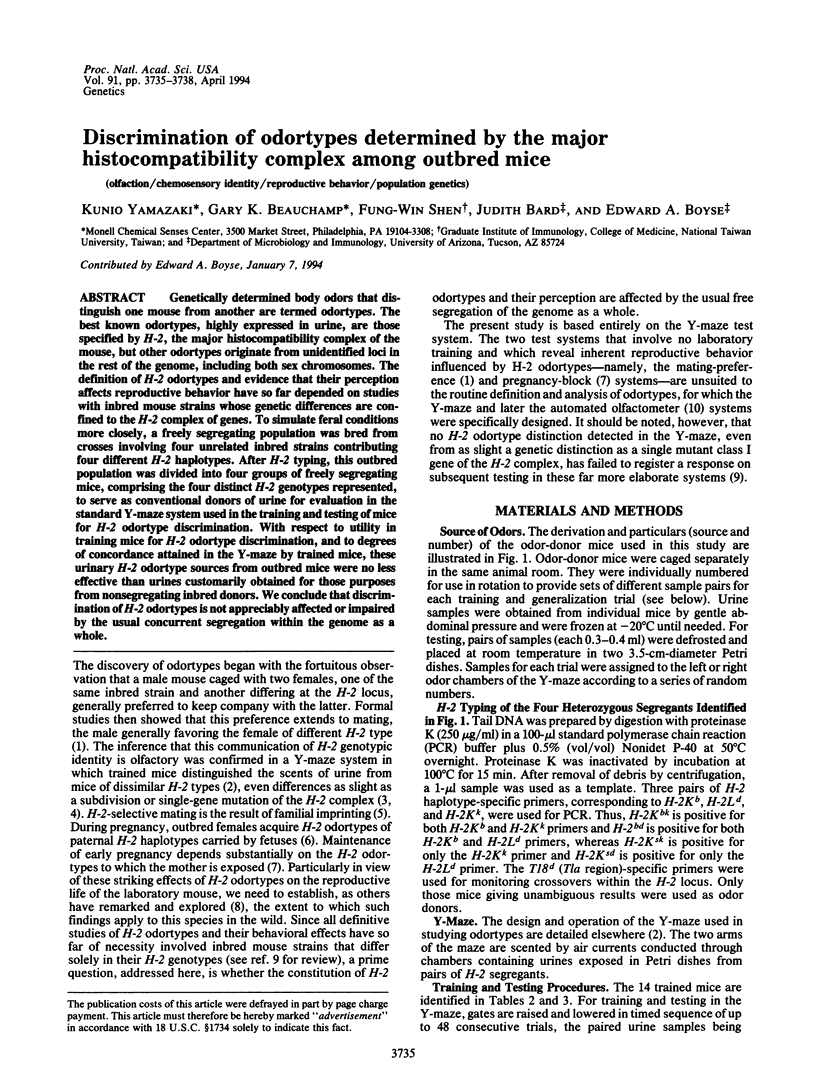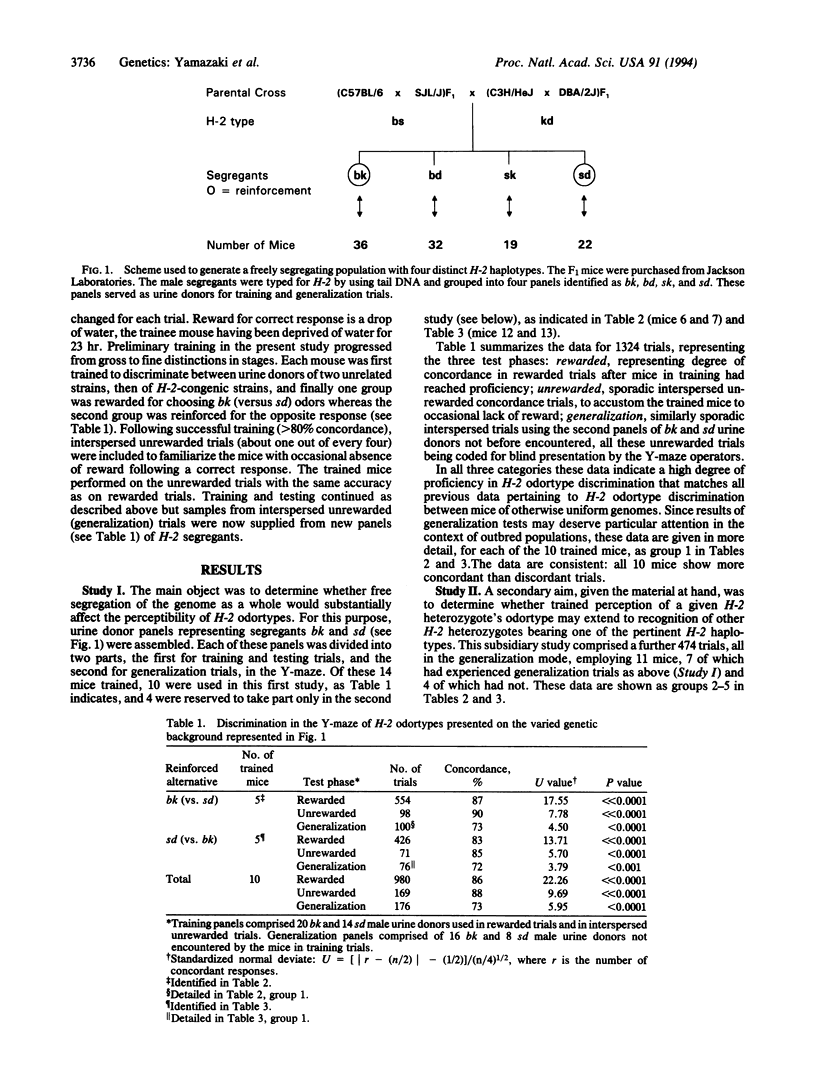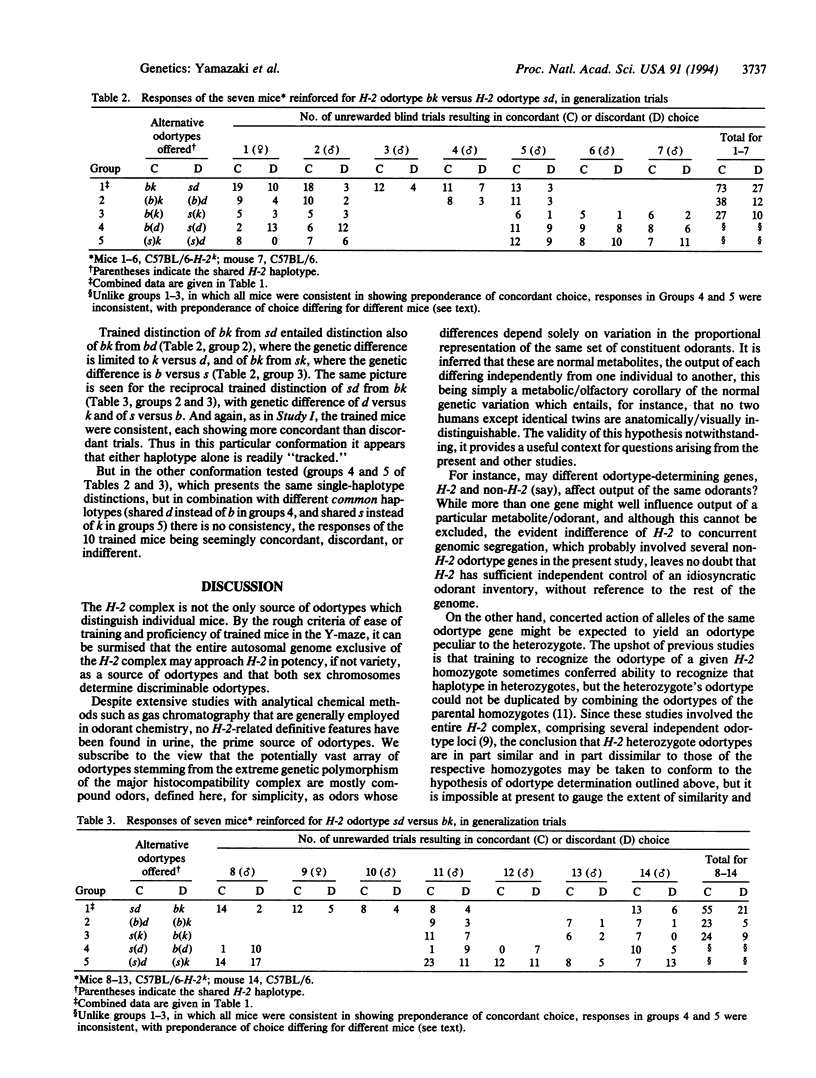Abstract
Genetically determined body odors that distinguish one mouse from another are termed odortypes. The best known odortypes, highly expressed in urine, are those specified by H-2, the major histocompatibility complex of the mouse, but other odortypes originate from unidentified loci in the rest of the genome, including both sex chromosomes. The definition of H-2 odortypes and evidence that their perception affects reproductive behavior have so far depended on studies with inbred mouse strains whose genetic differences are confined to the H-2 complex of genes. To simulate feral conditions more closely, a freely segregating population was bred from crosses involving four unrelated inbred strains contributing four different H-2 haplotypes. After H-2 typing, this outbred population was divided into four groups of freely segregating mice, comprising the four distinct H-2 genotypes represented, to serve as conventional donors of urine for evaluation in the standard Y-maze system used in the training and testing of mice for H-2 odortype discrimination. With respect to utility in training mice for H-2 odortype discrimination, and to degrees of concordance attained in the Y-maze by trained mice, these urinary H-2 odortype sources from outbred mice were no less effective than urines customarily obtained for those purposes from nonsegregating inbred donors. We conclude that discrimination of H-2 odortypes is not appreciably affected or impaired by the usual concurrent segregation within the genome as a whole.
Full text
PDF



Selected References
These references are in PubMed. This may not be the complete list of references from this article.
- Beauchamp G. K., Yamazaki K., Curran M., Bard J., Boyse E. A. Fetal H-2 odortypes are evident in the urine of pregnant female mice. Immunogenetics. 1994;39(2):109–113. doi: 10.1007/BF00188613. [DOI] [PubMed] [Google Scholar]
- Beauchamp G. K., Yamazaki K., Wysocki C. J., Slotnick B. M., Thomas L., Boyse E. A. Chemosensory recognition of mouse major histocompatibility types by another species. Proc Natl Acad Sci U S A. 1985 Jun;82(12):4186–4188. doi: 10.1073/pnas.82.12.4186. [DOI] [PMC free article] [PubMed] [Google Scholar]
- Potts W. K., Manning C. J., Wakeland E. K. Mating patterns in seminatural populations of mice influenced by MHC genotype. Nature. 1991 Aug 15;352(6336):619–621. doi: 10.1038/352619a0. [DOI] [PubMed] [Google Scholar]
- Yamaguchi M., Yamazaki K., Beauchamp G. K., Bard J., Thomas L., Boyse E. A. Distinctive urinary odors governed by the major histocompatibility locus of the mouse. Proc Natl Acad Sci U S A. 1981 Sep;78(9):5817–5820. doi: 10.1073/pnas.78.9.5817. [DOI] [PMC free article] [PubMed] [Google Scholar]
- Yamazaki K., Beauchamp G. K., Bard J., Thomas L., Boyse E. A. Chemosensory recognition of phenotypes determined by the Tla and H-2K regions of chromosome 17 of the mouse. Proc Natl Acad Sci U S A. 1982 Dec;79(24):7828–7831. doi: 10.1073/pnas.79.24.7828. [DOI] [PMC free article] [PubMed] [Google Scholar]
- Yamazaki K., Beauchamp G. K., Egorov I. K., Bard J., Thomas L., Boyse E. A. Sensory distinction between H-2b and H-2bm1 mutant mice. Proc Natl Acad Sci U S A. 1983 Sep;80(18):5685–5688. doi: 10.1073/pnas.80.18.5685. [DOI] [PMC free article] [PubMed] [Google Scholar]
- Yamazaki K., Beauchamp G. K., Kupniewski D., Bard J., Thomas L., Boyse E. A. Familial imprinting determines H-2 selective mating preferences. Science. 1988 Jun 3;240(4857):1331–1332. doi: 10.1126/science.3375818. [DOI] [PubMed] [Google Scholar]
- Yamazaki K., Beauchamp G. K., Thomas L., Boyse E. A. Chemosensory identity of H-2 heterozygotes. J Mol Cell Immunol. 1984;1(2):79–82. [PubMed] [Google Scholar]
- Yamazaki K., Beauchamp G. K., Wysocki C. J., Bard J., Thomas L., Boyse E. A. Recognition of H-2 types in relation to the blocking of pregnancy in mice. Science. 1983 Jul 8;221(4606):186–188. doi: 10.1126/science.6857281. [DOI] [PubMed] [Google Scholar]
- Yamazaki K., Boyse E. A., Miké V., Thaler H. T., Mathieson B. J., Abbott J., Boyse J., Zayas Z. A., Thomas L. Control of mating preferences in mice by genes in the major histocompatibility complex. J Exp Med. 1976 Nov 2;144(5):1324–1335. doi: 10.1084/jem.144.5.1324. [DOI] [PMC free article] [PubMed] [Google Scholar]


